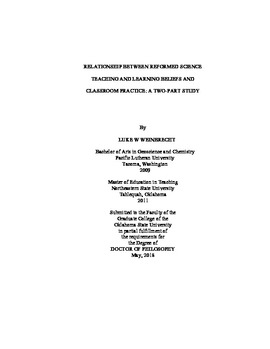| dc.description.abstract | Research examining the relationship between teachers' beliefs and classroom practice has been on the rise. While several researchers (Buehl & Beck, 2015; Fang, 1996; Pajares, 1992) have examined the relationship between teachers' beliefs and practice, there is not one agreed upon conclusion. This dissertation, presented as two studies, seeks to explore the relationship between secondary science teachers' beliefs and their self-reported classroom practice. The first study extends the application and use of the Beliefs About Reformed Science Teaching and Learning (BARSTL) (Sampson, Enderle, & Grooms, 2013) instrument as a way to (a) determine what secondary science teachers believe and (b) apply Grid and Group theory (Douglas, 1970, 1973, 1982; Harris, 2006) as a way to categorize teachers based on their beliefs. The second qualitative study utilizes the Grid and Group cultural map (Douglas, 1970, 1973, 1982; Harris, 2006) proposed in study one to create multiple-case studies to investigate teachers' classroom practice, as reported through interviews and lesson planning documents, based on their beliefs about the teaching and learning of science (Sampson et al., 2013). Overall results indicate a statistical difference teachers' beliefs and their education level and the number of undergraduate science courses taken. The Grid and Group typology allowed for visual representation of differences among the sample and the purposeful selection of participants for the case studies. The resulting multiple case studies found: (a) a cross-case belief regarding a focus on teaching the essentials, (b) consistency between traditional beliefs and practice but inconsistencies between reformed beliefs and practice, and c) support for the creation of a transitional zone on the cultural map similar to previous studies (Luft & Roehrig, 2007). Case studies illustrate change as a process that proceeds through transition, and at times conflict, between beliefs and practice. Findings support the inconsistency perspective between beliefs and classroom practice and illustrate the complex relationship between the two constructs. Classroom practice was self-reported, thus limiting the generalizability to other contexts and further research is needed utilizing direct observation. | |
